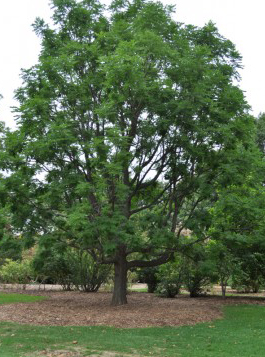Kentucky Coffee tree (Gymnocladus dioicus)
Category: Deciduous Trees

Kentucky coffee tree is a member of the Caesalpinioideae subfamily and Fabaceae family. It is found in North America and its seed is usually roasted and used in the place of coffee beans. Unroasted seeds and pods can be toxic. The wood from this tree is usually used by carpenters and cabinet makers.
Description
In height, the Kentucky coffee tree measures between 12 to 15 meters and has an excellent spread that can measure up to 15 meters. The diameter of the trunk is around 1 meter. At 10 years, this tree can stand about 4 meters in height. At about 3 meters above the ground, the Kentucky coffee tree separates into three or at times four divisions which end up forming a narrow pyramidal head. It then sends one central positioned branchless shaft that goes up to a height of 21 meters. The branches are characteristically blunt, pithy and stout while the roots are fibrous.
Flowering and Foliage
This tree has large leaves similar to the Devil's Walking-Stick and the Honey locust trees. The leaves are expanding and conspicuous because of their varied colored leaflets. When young, the leaves are bright pink and change into green or bronze as the tree matures. The leaves are bipinnately compound.
The flowers are dioecious while the fruits consist of a hard-shelled bean encapsulated in woody and thick-walled pods. The pulp of the fruits is thick and sweet. The pods vary in shape with a length that ranges between 5 and 10 inches.
Distribution
Kentucky Coffee tree is a rare species and its growth is monitored to determine its survival rate. It can be found in Southern Ontario and Kentucky. Other trees have been spotted in western Pennsylvania and Kansas.
Cultivation
This tree is cultivated as an ornamental plant in parks and gardens. It is a great urban plant because of its late-emerging and early-dropping leafing system. This combines well with the fact that it has large leaves.

 Back To Category Deciduous Trees
Back To Category Deciduous Trees